France Electric Vehicle Battery Materials Market Size
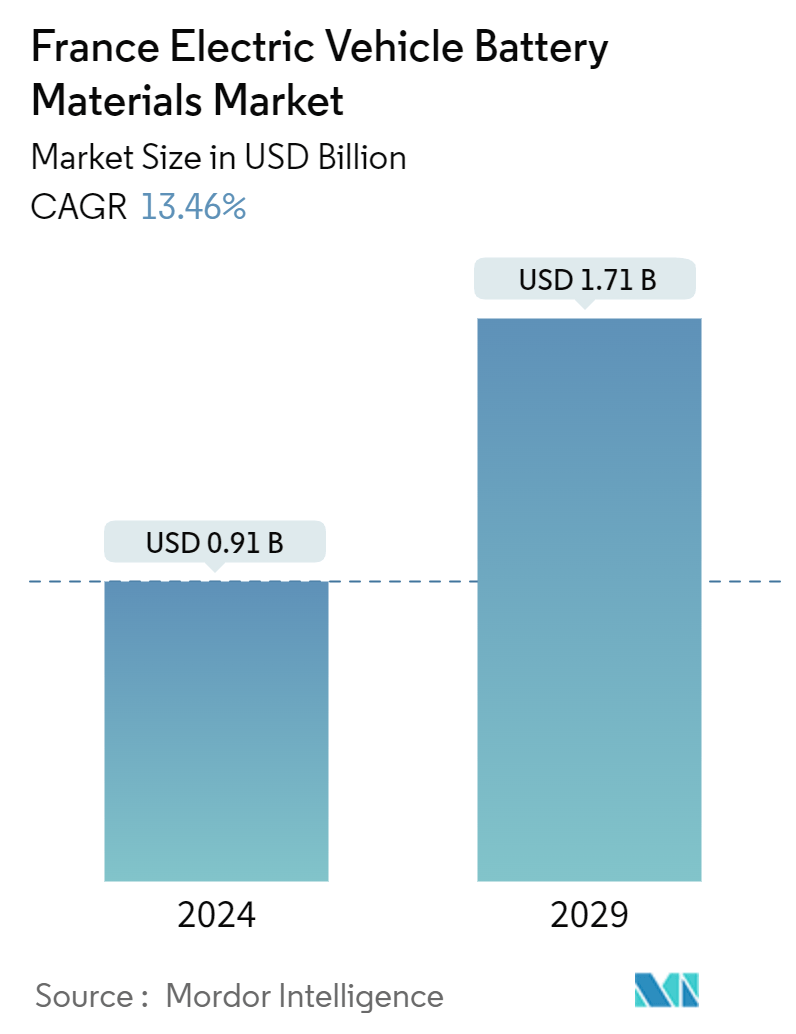
| Study Period | 2019 - 2029 |
| Base Year For Estimation | 2023 |
| Market Size (2024) | USD 0.91 Billion |
| Market Size (2029) | USD 1.71 Billion |
| CAGR (2024 - 2029) | 13.46 % |
| Market Concentration | Low |
Major Players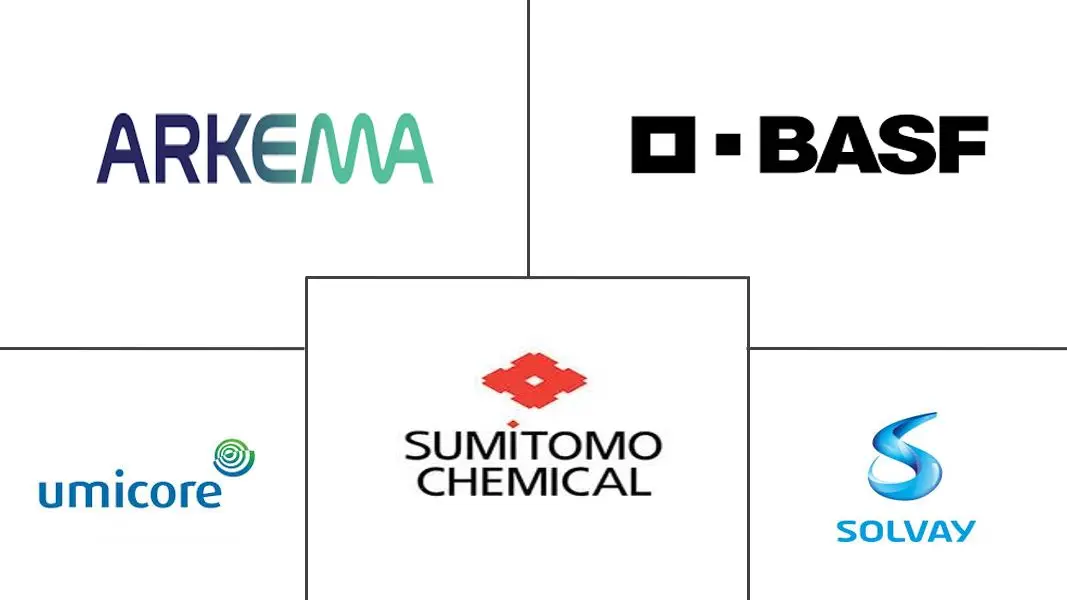
*Disclaimer: Major Players sorted in no particular order |
France Electric Vehicle Battery Materials Market Analysis
The France Electric Vehicle Battery Materials Market size is estimated at USD 0.91 billion in 2024, and is expected to reach USD 1.71 billion by 2029, at a CAGR of 13.46% during the forecast period (2024-2029).
- Over the medium term, growing electric vehicle (EV) sales and supportive government policies and regulations are expected to drive the demand for electric vehicle battery materials during the forecast period.
- On the other hand, the lack of raw material reserves can significantly restrain the growth of the electric vehicle battery materials market.
- Nevertheless, technological advancements in batteries like higher energy density, faster charging times, improved safety, and longer lifespan are expected to create significant opportunities for electric vehicle battery materials market players in the near future.
France Electric Vehicle Battery Materials Market Trends
Growing Electric Vehicle (EV) Sales Drives the Market
- In France, the rising sales of electric vehicles (EVs) are driving up the demand for EV battery materials. As sales of EVs climb, so does the need for key battery components like lithium, cobalt, nickel, and graphite. This heightened demand is not only boosting local production but also attracting investments, thereby invigorating the French battery material supply chain.
- France is making a pronounced shift towards clean energy, with electric vehicles taking center stage. Over recent years, EV sales in the country have seen a remarkable surge. For instance, the International Energy Agency (IEA) reported that in 2023, France sold 0.47 million electric vehicles, marking a 38.2% increase from 2022. Given this trajectory, the demand for battery materials is poised to rise significantly in the coming years.
- The French government actively champions the EV market's growth, rolling out subsidies, tax incentives, and enforcing stricter emission regulations. These supportive measures not only bolster the EV market but also extend their positive influence to the battery material industry. With an eye on the future, the government has set ambitious targets, aiming for a fourfold increase in EV sales.
- In a concrete move, the government inked a deal in May 2024 with top car manufacturers, setting a target of 800,000 electric vehicle sales by 2027, a significant jump from 200,000 in 2022. Additionally, with a commitment of 1.5 billion euros (approximately USD 1.6 billion), the government is backing various programs to stimulate both the production and purchase of electric vehicles. Such robust initiatives are set to not only boost EV production but also amplify the demand for battery materials.
- Moreover, France's vibrant EV market is a hotbed for battery technology innovation. Companies and research institutions in the country are channeling investments into pioneering materials that promise enhanced energy density, extended lifespan, and heightened safety. Collaborations among leading regional companies are further propelling advancements in battery technology, setting the stage for a surge in EV battery demand.
- Highlighting this trend, Arkema and ProLogium, in May 2024, unveiled their partnership focusing on Kynar PVDF grades and cutting-edge materials for ProLogium’s next-gen Lithium Ceramic Batteries. ProLogium also revealed ambitions to establish a gigafactory for lithium ceramic batteries in France. Such strategic moves are poised to not only amplify the demand for advanced EV batteries but also escalate the need for battery materials in the region.
- Given these dynamics, the trajectory for EV demand and the corresponding appetite for EV battery materials looks robust in the coming years.
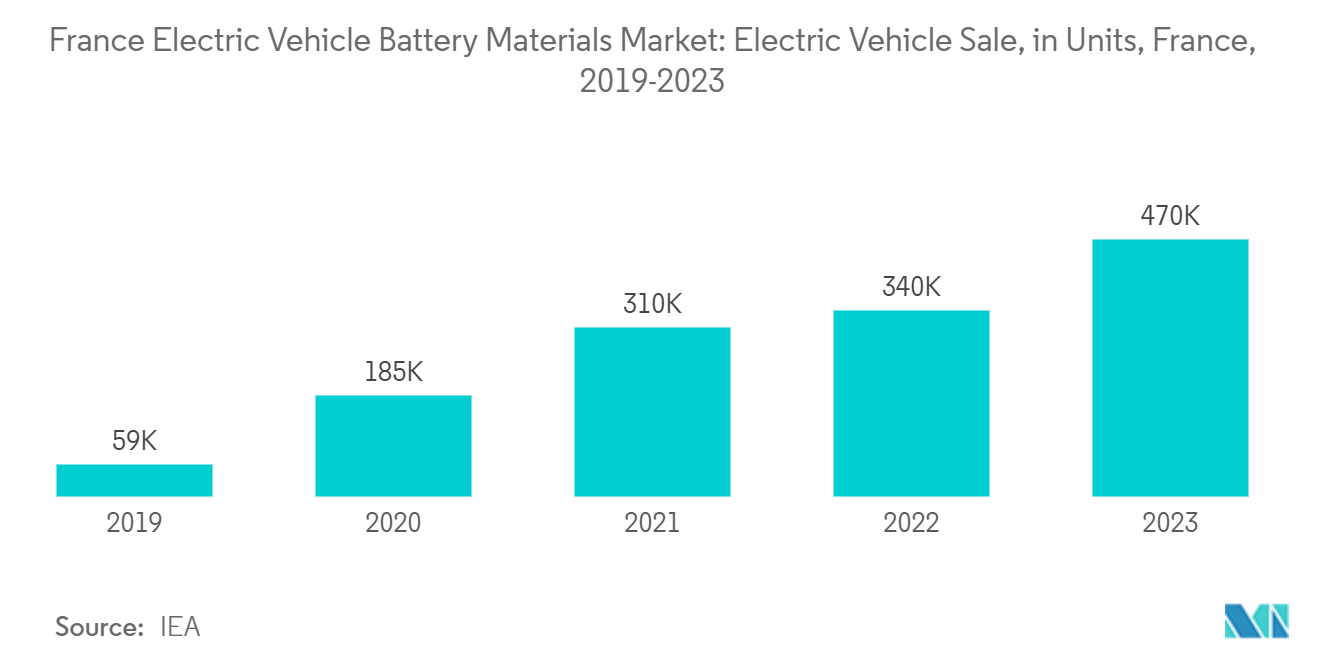
Lithium-Ion Battery Type Dominate the Market
- The production of lithium-ion batteries for electric vehicles (EVs) has surged, profoundly influencing the battery materials market. This uptick in battery production has driven a marked rise in lithium demand. Discoveries of lithium in various regions play a pivotal role in determining raw material costs.
- Key market players are channeling investments into lithium reserves and R&D, aiming to boost lithium-ion battery production and meet the escalating demand for battery raw materials. As new reserves are discovered, the prices of lithium-ion batteries have seen a downward trend over time.
- For example, in 2023, battery prices for electric vehicles (EVs) and battery energy storage systems (BESS) dropped to USD 139/kWh, marking a decline of over 13%. With ongoing technological innovations and manufacturing improvements, projections suggest battery pack prices could further dip to USD 113/kWh by 2025 and reach USD 80/kWh by 2030.
- In response to growing environmental concerns, European governments are actively championing lithium-ion battery production for EVs. With a keen focus on achieving net-zero carbon emissions, these governments have launched multiple initiatives to boost lithium-ion battery production, catering to the surging EV demand.
- For instance, in May 2024, Blue Solutions, a French firm, unveiled plans for a gigafactory in eastern France. With an investment of around 2 billion euros (USD 2.17 billion), the facility aims to produce a cutting-edge solid-state battery for EVs, boasting a rapid 20-minute charging time, with production slated to commence by 2030. Such endeavors are poised to bolster the adoption of lithium-ion batteries as a clean energy solution, subsequently amplifying the demand for battery materials.
- Additionally, in recent years, France has emerged as a leader in pioneering advanced recycling technologies for lithium-ion batteries. Both companies and research institutions are innovating efficient techniques to extract valuable materials, including lithium, cobalt, and nickel, from spent batteries.
- For instance, in July 2024, Hydrovolt, a prominent player, revealed its expansion into France with a new recycling facility in Hordain. Spanning approximately 3,000 square meters, this facility is set to commence operations in 2025 and will focus on recycling both EV and industrial batteries. Such strategic moves are not only accelerating the production of lithium-ion raw materials but also hint at a future surge in EV battery material production.
- Given these advancements and initiatives, a significant uptick in the demand for EV battery materials is anticipated during the forecast period.
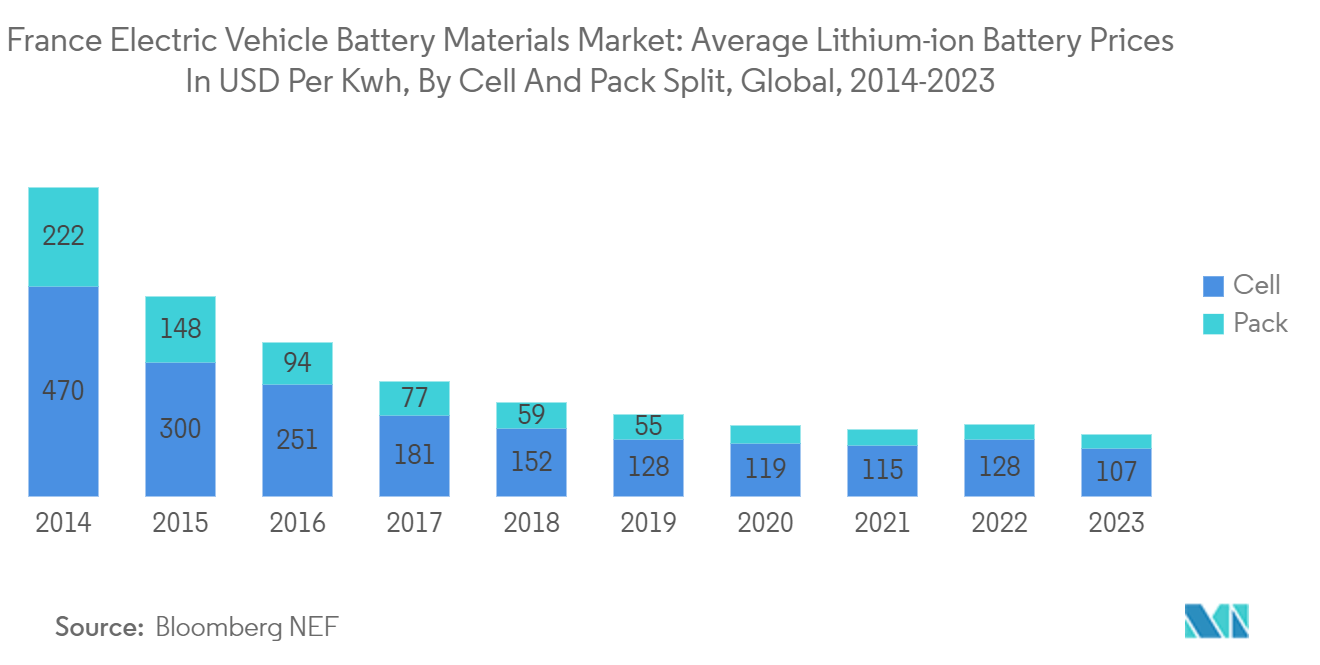
France Electric Vehicle Battery Materials Industry Overview
France's electric vehicle battery materials market is semi-fragmented. Some key players (not in particular order) are Sumitomo Chemical Co., Ltd., BASF SE, Arkema SA, Solvay SA, Umicore SA, among others.
France Electric Vehicle Battery Materials Market Leaders
-
Sumitomo Chemical Co., Ltd
-
Umicore
-
BASF SE
-
Arkema SA
-
Solvay SA
*Disclaimer: Major Players sorted in no particular order
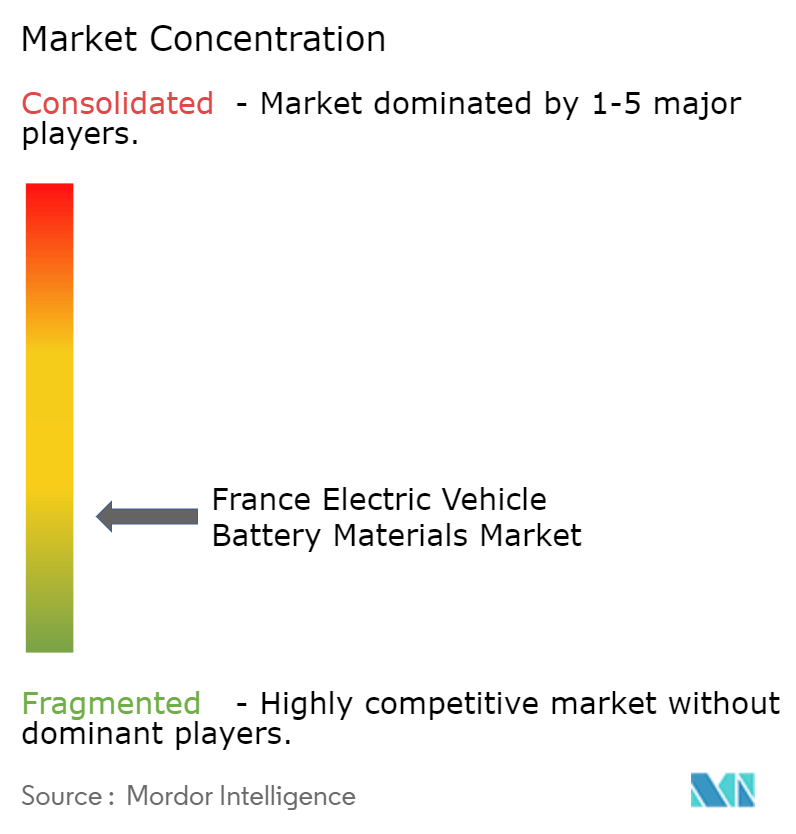
France Electric Vehicle Battery Materials Market News
- January 2024: EIT InnoEnergy and Demeter Investment Managers announced the launch of a fund dedicated to developing a resilient and diverse battery raw material supply chain in Europe. With a target size of EUR 500 million (USD 544.5 million), the EBA Strategic Battery Materials Fund is building to boost domestic capacities for EV battery materials such as lithium, nickel, cobalt, manganese, and graphite.
- September 2023: XTC New Energy Materials, a Chinese lithium-ion battery material supplier, is likely to build a CNY4 billion (USD542 million) ternary lithium-ion battery cathode material plant for EVs in France with local nuclear power producer Orano. The companies have set up a joint venture with a registered capital of EUR 20 million (USD 21.1 million) that is expected to be responsible for the construction and operation of the plant.
France Electric Vehicle Battery Materials Market Report - Table of Contents
1. INTRODUCTION
1.1 Scope of the Study
1.2 Market Definition
1.3 Study Assumptions
2. EXECUTIVE SUMMARY
3. RESEARCH METHODOLOGY
4. MARKET OVERVIEW
4.1 Introduction
4.2 Market Size and Demand Forecast in USD billion, till 2029
4.3 Recent Trends and Developments
4.4 Government Policies and Regulations
4.5 Market Dynamics
4.5.1 Drivers
4.5.1.1 Growing Electric Vehicle Sales
4.5.1.2 Supportive Government Policies and Regulations
4.5.2 Restraints
4.5.2.1 Lack of Raw Material Reserves
4.6 Supply Chain Analysis
4.7 PESTLE Analysis
4.8 Investment Analysis
5. MARKET SEGMENTATION
5.1 Battery Type
5.1.1 Lithium-ion Battery
5.1.2 Lead-Acid Battery
5.1.3 Others
5.2 Material
5.2.1 Cathode
5.2.2 Anode
5.2.3 Electrolyte
5.2.4 Separator
5.2.5 Others
6. COMPETITIVE LANDSCAPE
6.1 Mergers and Acquisitions, Joint Ventures, Collaborations, and Agreements
6.2 Strategies Adopted by Leading Players
6.3 Company Profiles
6.3.1 Sumitomo Chemical Co., Ltd.
6.3.2 BASF SE
6.3.3 Arkema SA
6.3.4 Solvay SA
6.3.5 Umicore SA
6.3.6 Eramet SA
6.3.7 Imerys SA
6.3.8 SAFT Groupe
6.3.9 Toray Carbon Fibers Europe
- *List Not Exhaustive
6.4 List of Other Prominent Companies
6.5 Market Ranking/ Share Analysis
7. MARKET OPPORTUNITIES AND FUTURE TRENDS
7.1 Advancements in Battery Technology
France Electric Vehicle Battery Materials Industry Segmentation
Electric vehicle (EV) battery materials refer to the raw materials and compounds used in the manufacturing of batteries specifically designed for electric vehicles. These materials are critical for the performance, energy density, lifespan, and safety of EV batteries.
France's electric vehicle battery materials market is Segmented by Battery Type and Material. By battery type, the market is segmented into Lithium-Ion Battery, Lead-Acid Battery, and Others. By materials, the market is segmented into Cathode, Anode, Electrolyte, Separator, and Others. The Report Offers the Market Size and Forecasts in Revenue (USD) for all the Above.
| Battery Type | |
| Lithium-ion Battery | |
| Lead-Acid Battery | |
| Others |
| Material | |
| Cathode | |
| Anode | |
| Electrolyte | |
| Separator | |
| Others |
France Electric Vehicle Battery Materials Market Research FAQs
How big is the France Electric Vehicle Battery Materials Market?
The France Electric Vehicle Battery Materials Market size is expected to reach USD 0.91 billion in 2024 and grow at a CAGR of 13.46% to reach USD 1.71 billion by 2029.
What is the current France Electric Vehicle Battery Materials Market size?
In 2024, the France Electric Vehicle Battery Materials Market size is expected to reach USD 0.91 billion.
Who are the key players in France Electric Vehicle Battery Materials Market?
Sumitomo Chemical Co., Ltd, Umicore, BASF SE, Arkema SA and Solvay SA are the major companies operating in the France Electric Vehicle Battery Materials Market.
What years does this France Electric Vehicle Battery Materials Market cover, and what was the market size in 2023?
In 2023, the France Electric Vehicle Battery Materials Market size was estimated at USD 0.79 billion. The report covers the France Electric Vehicle Battery Materials Market historical market size for years: 2019, 2020, 2021, 2022 and 2023. The report also forecasts the France Electric Vehicle Battery Materials Market size for years: 2024, 2025, 2026, 2027, 2028 and 2029.
France Electric Vehicle Battery Materials Industry Report
Statistics for the 2024 France Electric Vehicle Battery Materials market share, size and revenue growth rate, created by Mordor Intelligence™ Industry Reports. France Electric Vehicle Battery Materials analysis includes a market forecast outlook for 2024 to 2029 and historical overview. Get a sample of this industry analysis as a free report PDF download.



